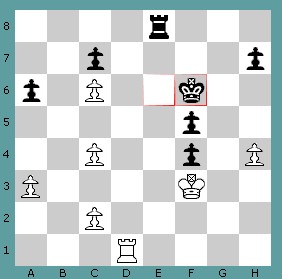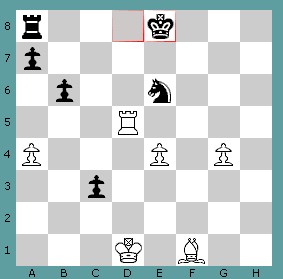
STANLEY RANDOM CHESS MONTHLY

Draws are much rarer in SR Chess than Common Chess, although perhaps less rare than most players think. In this article, GM Topov discusses some of the conditions required for a draw, and analyses some games.
It is widely known that draws are much rarer in SR Chess than Common Chess, which is one of the reasons why the original form of the game has so much to commend it above Simplified SR Chess (traditional chess). One reason for this is that mutually agreed draws are illegal in SR Chess. Under ISRCA rules, players found guilty of making a Premature Draw Offer (P.D.O.) immediately have their Membership status in the organization downgraded to the Provisional Associate level, and upon a second offence are banned for life from tournament play. GM Walter Pittman of Los Angeles was the most recent player to be banned for this offence in 2002, although in his case the penalty was much more severe on account of evidence of piece-tampering and bribery of an associate adjudicator.
Draws are permitted however, and in fact are strictly mandatory when the following conditions are satisfied:
A somewhat symmetrical position increases the possibility of the fourth and fifth of these conditions being in effect, which is why it is usually avoided by the best grandmasters. Leopold Strauss has a brief chapter on draws in his excellent text "A Reexamination of Forced Inferior Material Resignations: A Guide to Winning Play under VollenHauser Conditions" (Belgrade Press, 1934). He makes mention of the fact that under the influence of two Italian grandmasters at the end of the 17th century, there was a short-lived movement in SR playing circles called "Gioco Per Tiraggio" ("Playing for the Draw"), but this movement was quickly abandoned when it was discovered that it required players to compromise lateral shift in the openings that were standard at the time.

|
| 31...Kf6 |
This game is a clear illustration of how the risk of creating the modal squares required to achieve a draw necessitates a weak pawn structure shortly after the "Punto Intermedio." Good players will usually be able to turn this into a win before VH Conditions come into effect. As a result, draws at the highest level are more rare than in casual play.
In the above game, it is 11.Bxc3+? that White plays which leads to this position. As you can see, it also creates some of the symmetry apparent at the end of the game. A strong player would usually respond with 11...Qxd4, and because the pawn on c3 would be frozen, white would be forced to play 12.Qe2, and after 12...Qxc3+ the game is virtually lost for White. But the game is certainly worth studying for its merits as a good contest between amateurs (24...Re7! gives good compensation to unbalance the light squares).

|
| 37...Ke8 |
This is a fine example of a rare SRC draw, once again in a game between two amateurs. Although both players adopted a somewhat light-hearted approach to the game, the final part of the game under VH Conditions is worthy of special consideration, particularly 35.Bf1. Note that while 35.BxRc8 would have set up a classic IMR trap sequence, in fact the Forced IMR position would be non-Inveterate after 36.Rf5 (necessary to occupy the important f5), and thus reversible. Instead, White plays 35.Bf1, enabling black to secure a draw after 37.Rxd5+. Note also that while 14.Qxh6? is a decent move in regular chess, here it creates maximum modal squares, thus opening up the possibility for the end-game draw. The unusual 14.Qg5 was perhaps safer.
It is self-evident from Conditions 1 and 2 that this draw was only possible because VH Conditions were in effect after the 30th move, and neither player had a material advantage in the final position.

|
| 31.Ke2 |
On this occasion the symmetrical aligning of both kings on the e file (after 31.Ke2) results in a Forced IMR position which is clearly Inveterate, after 31...Bb8 32.Bb2 Bb7, from which point it is reversible. It goes without saying that neither player has unranked pawns that meet a Statutory Pawn Condition, and in fact only one is over-extended, but blocked, thus preventing the Condition. As others have pointed out, technically this draw is classified as Ebenezer's Dithering Construct (2nd version, according to the 1904 Ruling).
In this game it is 9.bxa3 that resulted in maximum modal squares of opposite colours prior to the Punto Intermedio. While it gains material, the Carrot Gambit (8...Qa3) usually must be declined because of the unweighting of the pawns it creates, and of course the modality, which in this game led to the draw. Many players would instead opt for 9.NxB, with a Delayed Check to follow, after 9...Bg7 (necessary to preserve the diagonal, and retain counter-balance).
For a more specialized study on one particular draw sequence, see the article Titus Livius and the Saragossa Draw Position.
SR Chess GM Gregory Topov
Posted Tuesday - 2006-04-04 - 12:07:25 EST
by Staff Reporter Verdra H. Ciretop in Toronto
All Rights Unreserved - Loof Lirpa Publishing
Text may be freely copied & redistributed